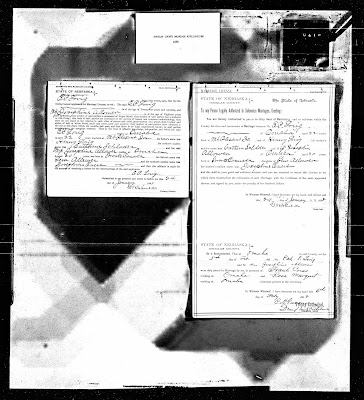Edd Lorig, ca 1919
Lorig Family history update. The update comes as somewhat of a shocker. We recently learned that Edd Lorig had been married first to Josephine Allower, on 5 February 1888 in Omaha, Douglas, Nebraska. Josephine was born in Toronto, Ontario, Canada, in 1868 the daughter of Lew Allower and Josephine Evers. It is likely that the Allower name was changed from the French-Canadian spelling of the name Alloir [Alloyier] or Alloir-Roy to the more English Allower. Her father’s given name mostly likely was Louis rather than Lew. We do not know what happened to Josephine or how the marriage ended.
State of Nebraska, Trinity Cathedral, Omaha—marriage certificate 1888
Edd’s name on the 1888 marriage certificate is listed as E.P. Lorig. His parents are listed as: Henry Lorig and Catherine Schloeder. His birthplace is given as Mt. Pleasant, Henry, Iowa. These facts fit the records we already have. Helen Fuqua, the granddaughter of Edd’s sister, Maggie [Margaret] Lorig Ford, said that her grandmother always called her brother Pete or Peter rather than Edd; however, Edd’s baptismal record does not show a second or middle name.
There are a few additional records to check to see if we can piece more of the history together. Since Edd is listed on the 1892 Washington Territorial census as single, and two years later married Maggie Landaas in 1894, we can determine that something happened between 1888 and 1892 that ended his first marriage. Oral history suggests that he may have been in Seattle as early as the time of the 1889 fire but that needs to be confirmed. A first wife was never mentioned. Either Josephine died, the marriage was annulled or they divorced, or they separated without benefit of a legal process. So far, no children from this first marriage have been discovered. In any event, this first marriage was a short one, possibly only one year or up to almost 4 years in length.
At first it was thought that Edd’s sister, Elizabeth, and her husband, Charles Keller, were already in Seattle and that was why he came out west. However, they were still living in Chicago in 1910 according the census record. What else could have caused him to travel across the country from Nebraska or Iowa to Seattle? Perhaps it was because this was still the time period during the Alaska gold rush and Seattle was a boom town, the starting place for heading north to the gold fields. It was a natural destination for many, especially young, single men.
St. Michael’s Episcopal Church, parish register, 1867, Mt. Pleasant, Iowa
Concerning Edd’s first name, he was always called, and wrote his name just as Edd. When he and two of his sisters, Mary Magdalene and Margaret Mae, were baptized in 1867 at St. Michael’s Episcopal church in Mt. Pleasant, Iowa, his given name is written Edolph. The witnesses at the baptisms were their parents and their maternal uncle, Adolph [written Edoph] Schloeder. We see that Edd was named after his uncle, a common practice. Some have thought there were two sons, Edward and Edolph, and two daughters, Margaret and Margaritte; however, that is not the case. These three children, Mary, Margaret and Edd, were baptized as young children instead of infants mostly likely because there was no German speaking Catholic church near where they lived. Their German speaking parents may have thought the Episcopal church was a Catholic church or they may just have wanted to have the children baptized in a German language church. Uncle Walt Lorig reported that his father always said there were 6 children in his family and he, Edd, was the only boy among the girls. FamilySearch.org shows 8 children but two, Edolph and Margaritte, are duplicates, they are Edd and Margaret [Maggie].
1870 U.S. Federal Census
Only three years after the baptisms, on the 1870 U.S. Federal Census for Iowa, the family is found on lines 7-14 with the surname written not as Lorig but as Larice, with Henry [head of household], Catherine [wife], children: Anna [15], Elizabeth [13], Mary M.[10], Margaret [8], Adolph (aka Edd) [5], and Martha [1].
Marriage certificate, 1894, Edward Lorig and Maggie Landaas
On the marriage certificate in 1894 to Maggie Landaas, Edd signs his name as Edward Lorig. Then on the 1900 U.S. Federal Census for Washington Edd is found again as Edward Lorig with Maggie as his wife, and children: Clara E., Harry and Walter. On the subsequent, 1910, 1920, 1930 and 1940 U.S. Federal Census records his name continues to appear as Edward Lorig.
If I find more information, I will update again.





















